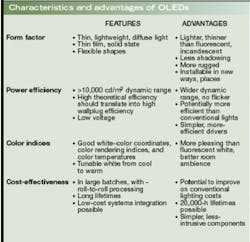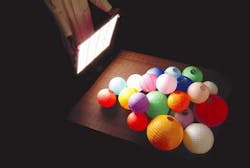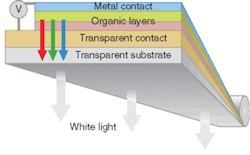Organic-LED technology is emerging as the next generation of ambient white light for general illumination.
Imagine your office with overhead lighting that is warm and inviting rather than harsh and headache-inducing. Imagine your home with curtains and furniture that illuminate the room in soft and soothing ways, mimicking the outdoors. Now imagine that such light sources are more cost-effective, energy efficient, and environmentally friendly than conventional fluorescent and incandescent fixtures.
Sound far-fetched? The U.S. Department of Energy (DOE), lighting companies, and materials researchers worldwide don't think so. They have all identified organic light-emitting diodes (OLED) as the next generation of white-light sources for general illumination. According to proponents, OLED light sources are lighter, thinner, more rugged, more efficient, and easier on the eye than conventional lighting and more suited to large-area applications than LEDs (see table). In addition, given their broad spectral coverage, white OLEDs offer a kind of "situational tunability"—that is, with OLEDs the ambient lighting can be altered from cool to warm, depending on whether the room is being used for a business meeting or a dinner party. In fact, by varying the chemical structure of the emissive species, mixing different emissive species, or modifying device structure, OLEDs offer enormous flexibility in spectral tuning.
According to the DOE, general lighting for commercial, residential, and industrial buildings accounts for nearly 20% of total U.S. power consumption—a cost of more than $20 billion annually. In addition, the fabrication of incandescent and fluorescent lighting takes a toll on the environment; production methods require burning fossil fuels, which exacerbates global water- and air-pollution conditions and waste disposal. The DOE has embarked on a mission—dubbed the Next Generation Lighting Initiative (NGLI)—to bring more energy-efficient lighting into the marketplace, pouring millions of dollars into research projects designed to yield new solid-state light sources. Early focus has been on LEDs, which have gained a foothold in the lighting market by improving the durability, brightness, and lifetimes of point-source illumination products such as traffic signals (see Laser Focus World, December 2003, p. 62).
More recently, attention has turned to OLEDs for general illumination. OSRAM Opto Semiconductors (Regensburg, Germany and San Jose, CA) is using $4.65 million from the DOE (plus $4.65 million of its own money) to develop and fabricate a 12-in.-square polymer OLED white-light prototype. Similarly, Universal Display (Ewing, NJ) has a DOE grant to develop efficient white-light sources using phosphorescent OLED technology. As part of another DOE-supported project, General Electric Global Research (Niskayuna, NY) demonstrated a 2 × 2-ft OLED panel that produced 1200 lumens of light at 15 lumens/W—comparable to incandescent bulbs (see Fig. 1).
FIGURE 1. Using blue-emitting OLED arrays coated with white phosphor, researchers at General Electric Global Research have demonstrated a 2 × 2-ft lighting panel capable of producing 1200 lumens of light at 15 lumens/W.
"Why OLEDs for lighting? Because the potential for tremendous efficiency—on the order of 150 lumens/W—is there," said Ed Petrow, a consultant to the DOE on the NGLI. "They offer the potential for inexpensive manufacturing and their form factor is limited only by your imagination. In addition, OLEDs better approximate the spectrum of the sun. Through OLEDs we can create a lighting system that humans are comfortable with and that is energy efficient and easy to produce."
Lighting vs. displays
An OLED is a solid-state device made up of thin layers of organic films that emit bright light upon electrical stimulation (see Fig. 2). Because displays have represented the first major commercial application for OLEDs, the focus of much OLED R&D has been on high-resolution, low-power, multicolor capabilities for flexible materials (see Laser Focus World, March 2004, p. 65). When it comes to lighting, however, while OLED configurations still rely on a mixture of colors, device designs differ fundamentally from those used in flat-panel displays because the need is for energy-efficient white light that is diffuse rather than focused.
FIGURE 2. An OLED device comprises one or more semiconducting organic thin films sandwiched between two electrodes, one of which must be transparent. With the appropriate mix of molecules in the organic layers, OLEDs can emit white light.
Numerous methods for making white-emitting OLEDs have been demonstrated, with much of the emphasis on illumination quality. In the mid-1990s, researchers at Yamagata University first demonstrated that white light could be generated by doping various dyes into a polymer layer or in different layers of a small-molecule device. Subsequent approaches have included a subset of dyes in one layer combined with dyes in separated layers, and blocking layers between separate dye-doped layers to better control exciton formation and energy transfer. For polymer devices, most white-device demonstrations have focused on single-emission layers, through dye doping or conjugated polymer blends. Other approaches include utilizing the emission of excited states involving two identical (excimer emission) or different (exciplex emission) molecules and using microcavities to selectively enhance spectral components.
General Electric is leading the pack in the development of OLED-based lighting, in part because the company has focused solely on this technology for lighting. The company began seriously pursuing OLEDs in 1999; this work led to the development of blue-emitting OLED arrays that can be coated with white phosphor to create a large-area flat-panel illumination source. The device comprises a blue-light-emitting polymer-based OLED deposited on a glass substrate; on the reverse side of the glass is a series of down-conversion layers consisting of organic molecules (perylene orange and perylene red) and inorganic phosphor particles.
According to Anil Duggal, manager of the light-energy conversion program at GE Global Research, this approach has been shown to yield an overall increase in power efficiency due to the high quantum efficiency of the phosphors and light scattering in the phosphor layers. In addition, illumination-quality white light can be generated over the full range of color temperatures required for lighting applications; in the lighting world, a lower color temperature corresponds to a warmer light because of the higher red component, while a higher color temperature corresponds to a colder light because of the higher blue spectral component. The GE technology also lends itself to the high-volume, low-cost processing necessary for general lighting applications.
"There are big differences in how you would design a device for lighting versus display," Duggal said. "For lighting, you have to worry much more about cost and fault tolerances than with displays, and you have to think right away about producing it in roll-to-roll processing vs. batch processing. It has to be fault tolerant, which means you can't throw away the whole sheet, so we came up with different design approaches that address this."
In mid-2003, GE researchers announced a breakthrough in overcoming certain fault tolerances that have inhibited the scalability of OLEDs for large-scale illumination (see Laser Focus World, July 2003, p. 38). By dividing a large-surface OLED into separate smaller sections with criss-cross connections between anodes and cathodes, the researchers found they could circumvent a catastrophic failure. In this geometry, a short circuit affects only one element rather than the entire device; in addition, the resistivity ceases to be a problem for small elements. The company's long-term goal is to create sheets of paper-thin lighting devices that can be applied to surfaces like wallpaper, replacing fluorescent lighting. Initial applications are expected to be in architectural lighting; broad-scale general lighting applications are about 10 years away.
Two colors or three?
Universal Display is taking a slightly different approach, building upon the expertise its researchers have gained in phosphorescent OLEDs (PHOLEDs) for displays. According to the company, this technology has demonstrated power efficiencies up to four times higher than other OLED materials, which should translate into the 100-lumens/W range for lighting.
"White light is a subset of our PHOLED technology," said Janice Mahon, vice president of technology commercialization for Universal Display. "You can produce white by doping the OLED structure with RGB structures. If you mix two colors to get white versus three colors to get white, you will get different qualities of white, some of which are more appropriate for general lighting than others."
Universal Display is pursuing both two-color (blue-yellow) and three-color (RGB) configurations. The company has also investigated a monomer-excimer approach that involves using a different dopant that, as it is charged, emits in the yellow as well as the blue. Another approach involves putting layers of RGB side-by-side in stripes so that the light appears white to the eye upon emission.
At this point, however, much materials work still must be done, according to Mahon. In addition to the need for lifetimes of 20,000 hours or more at levels much brighter than for displays, the question of whether two-color white-light OLEDs are preferable to three-color is complicated by the fact that there has been much less work done in developing yellow LEDs. In addition, as with OLED displays, there are still barrier-film and manufacturing challenges to be overcome before OLED lights can be mass-produced.
"To get to the costs required for lighting, producing light sources the way they produce displays today just won't cut it," Mahon said. "There is a need for a plastic, web-based format, and we have spent a lot of time working on OLEDs on plastic and other flexible media, such as stainless steel." Universal Display is also working to improve light-extraction efficiencies for PHOLEDs by using a flattened lens array.
Osram, which owns the lighting company Sylvania, believes it has a leg up when it comes to manufacturing OLEDs because the company has focused on polymers from the start. According to Homer Antoniadis, program manager of R&D at Osram, the company has been working on polymer-based OLEDs for several years, focusing on solution coating and patterning techniques, and already has display products on the market. The white-light prototype being developed through the company's DOE grant will be based on multiple discrete 3-in.-square white-light devices fabricated on glass substrates. For this project, which began last October and runs through 2006, the company is pursuing two approaches: a broadband light-emitting copolymer for white-light generation from a single large-area emitting film or a small number of segmented emitting films, and a larger array of color tri-stripes of RGB polymer emitters combined with a light diffuser. In both cases, molecularly dispersed triplet emitters are being investigated to improve efficiencies.
"Our approach to polymer OLEDs for lighting relies on a large-molecule solution process where you build thin fields from the solution," Antoniadis said. "You can achieve a white-emitting device that is stacked or striped or one blue-light device that is coated (with phosphors); at Osram, we have proposed to use true white-emitting materials so the light comes from the polymer molecules themselves. With OLEDs we have the opportunity to miniaturize RGB to the molecular level and the advantage is you have a single layer that emits white light, which should be more cost effective."
For the next few years, GE, UDC, Osram, and others will continue to refine the materials and the manufacturing processes used to create OLED lighting. In fact, there is a clear consensus on the timeline for commercial adoption of this technology: five years for specialty lighting, ten years for general lighting.
"From where the technology is today, a number of key targets remain," Mahon said. "In terms of power efficiencies, 50 to 80 lumens/W is the goal. In addition, we need 20,000-hour lifetimes at 800 to 1000 cd/m2. The third metric is cost. To get into general lighting we need to go from dollars per square inch to pennies, nickels, and dimes per square inch. Some of this will happen when we take patterning out of the equation and when we start producing at high throughputs on web-based, roll-to-roll, or inline processes."


